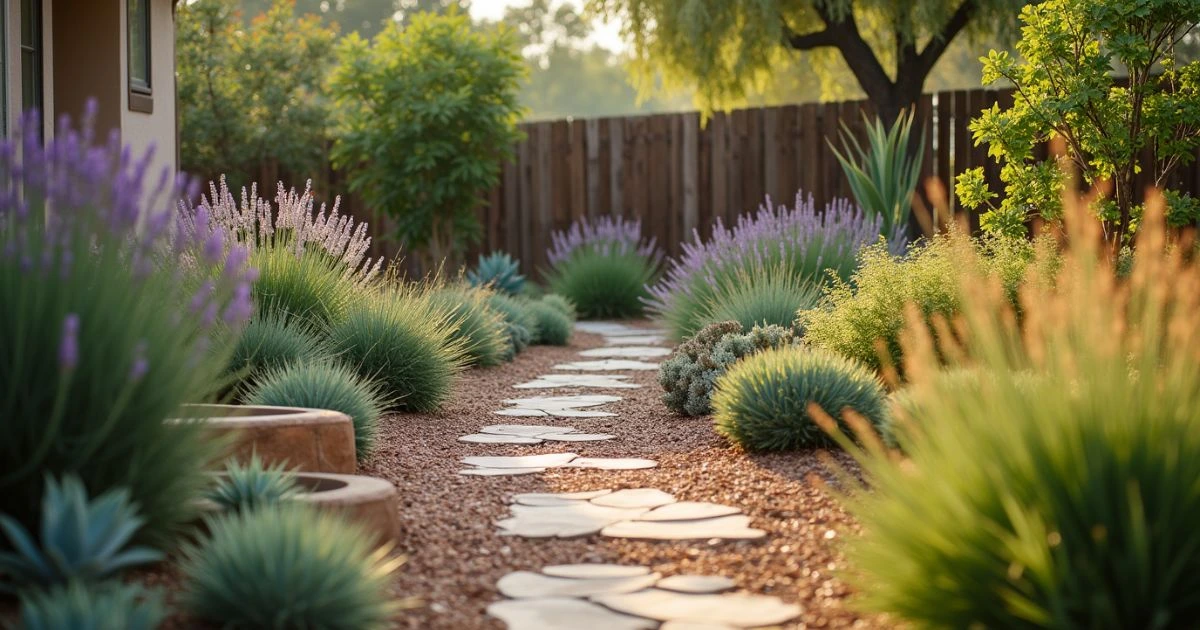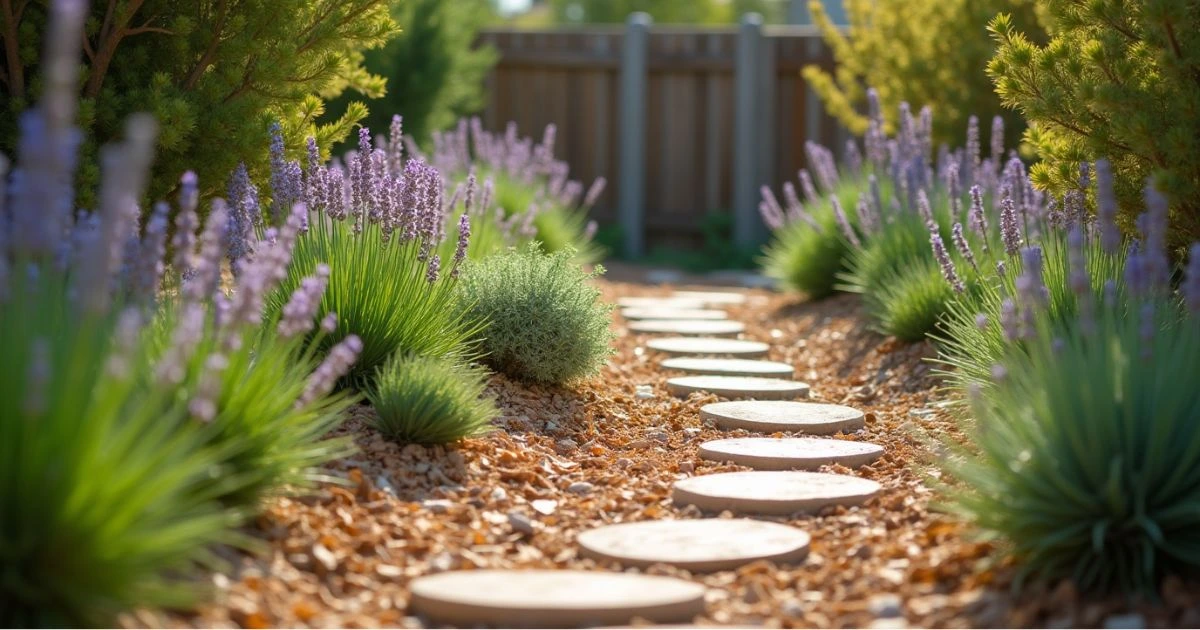Picture a yard that’s lush and vibrant without the constant need for watering. This is the essence of xeriscape ideas—a sustainable, water-saving approach to landscaping that’s perfect for those looking to conserve water, save on maintenance, and create an eco-friendly outdoor space.
Whether you live in a hot, dry climate like Texas or just want to reduce your water bills, xeriscaping can transform your yard into a stunning, drought-tolerant haven. In this guide, you’ll discover seven proven xeriscape landscaping ideas that will help you save water and create a low-maintenance, beautiful yard.
Let’s dive into how you can achieve a stunning, water-wise landscape through xeriscaping.
Table of Contents
What Is Xeriscaping? Why It’s Perfect for a Water-Wise Yard
Xeriscaping involves designing landscapes that minimize water usage without sacrificing beauty or function. The focus is on drought-resistant plants, efficient irrigation, and the careful selection of materials that help retain moisture. This landscaping method is especially important in dry areas like Texas, where water conservation is crucial.
Why Xeriscaping Works:
- Conserves Water: Xeriscaping can reduce water usage by up to 70%.
- Saves Money: With lower water usage, your utility bills will decrease significantly.
- Low Maintenance: Once established, xeriscaped gardens need less upkeep compared to traditional landscapes.
- Better for the Environment: Xeriscaping supports biodiversity, prevents soil erosion, and reduces runoff.
It’s the ideal solution for Texas xeriscape ideas or anywhere dealing with drought and high water costs. By using xeriscape Texas principles, you can achieve a beautiful yard while conserving water and reducing environmental impact.
7 Stunning Xeriscape Ideas for a Water-Wise Yard
1. Choose Native and Drought-Tolerant Plants

One of the most important aspects of xeriscaping is selecting the right plants. Native plants, which are adapted to local conditions, thrive without heavy watering and can survive on natural rainfall. In Texas xeriscape ideas, native plants like the Texas sage, bluebonnets, and yucca are great choices. These plants can withstand the hot, dry Texas summers while adding vibrant color to your garden.
Other Drought-Tolerant Plant Options:
- Red Yucca: Perfect for Texas, with minimal water requirements.
- Blackfoot Daisy: A hardy perennial that blooms in dry conditions.
- Mexican Feather Grass: Adds texture and movement to your garden with minimal water needs.
By using native and drought-tolerant plants, you ensure your xeriscape thrives even in the driest conditions while reducing your need for irrigation.
2. Create Hydro-Zones for Efficient Watering

Different plants have varying water needs. That’s why hydro-zoning—grouping plants with similar water needs together—is an essential principle of xeriscaping. Hydro-zoning helps conserve water by ensuring that each plant receives just the right amount, without wasting water on plants that don’t need it.
How to Hydro-Zone Your Yard:
- High-Water Zone: Place plants that require more water, such as vegetables or tropical flowers, in an area near your irrigation source.
- Moderate-Water Zone: Place plants like wildflowers or shrubs that thrive with occasional watering in a middle zone.
- Low-Water Zone: Group drought-tolerant plants like succulents and ornamental grasses in areas that receive the least water.
This technique is especially effective when designing xeriscape landscaping ideas in regions like Texas, where water conservation is a priority.
3. Replace Lawns with Ground Covers

Conventional lawns need a lot of water to remain lush and green. Alternatively, you can replace your lawn with drought-tolerant ground covers that offer beautiful textures without the need for water-intensive maintenance. Ground covers are an essential part of zero landscape ideas, allowing you to create a sustainable garden without wasting water.
Ground Cover Options:
- Creeping Thyme: A fragrant, water-efficient ground cover that thrives in dry conditions.
- Sedum: This low-maintenance succulent stores water in its leaves and can be used to fill spaces between larger plants.
- Buffalo Grass: A hardy native grass that requires much less water than traditional turf grass.
These ground covers not only save water but also reduce the need for mowing and trimming, making your garden even easier to care for.
4. Use Mulch to Retain Moisture

Mulch is an invaluable tool in xeriscaping. By covering the soil with a layer of mulch, you help retain moisture, prevent soil erosion, and suppress weed growth. This reduces the amount of water your garden needs while promoting healthier plants.
Types of Mulch for Xeriscaping:
- Wood Chips: These organic mulches break down over time, enriching the soil with nutrients.
- Gravel or Rocks: A popular choice for Texas xeriscape ideas, these inorganic mulches help retain moisture while adding a stylish, modern look to your garden.
- Straw: A lightweight option that decomposes slowly and keeps the soil cool.
Mulch is especially effective in dry regions, where moisture retention is key to a successful xeriscape design.
5. Add Hardscaping Features

Incorporating hardscaping into your xeriscape design can significantly reduce your water usage. By replacing large grassy areas with patios, walkways, and retaining walls, you minimize the area that requires water while enhancing the overall aesthetic of your yard.
Popular Hardscaping Ideas for Xeriscaping:
- Stone Pathways: Create beautiful, natural walkways using flagstone, pebbles, or gravel.
- Dry Creek Beds: These channels help direct rainwater and prevent runoff, all while adding an attractive feature to your garden.
- Patio Areas: Use eco-friendly materials to create a space for relaxation and entertaining without needing to water a lawn.
Hardscaping elements not only save water but also add functional beauty to your garden design.
6. Install Efficient Irrigation Systems

Even with drought-tolerant plants, you may still need to water your xeriscape occasionally. Installing an efficient irrigation system is essential for maintaining a healthy garden. These systems direct water precisely where it’s needed, reducing waste and promoting sustainability.
Efficient Irrigation Options:
- Drip Irrigation: Ideal for delivering water directly to plant roots, minimizing evaporation.
- Soaker Hoses: These hoses distribute water evenly along the soil, ensuring your plants are hydrated without excess runoff.
- Rain Barrels: Collect rainwater for reuse, helping you further reduce your reliance on municipal water sources.
By integrating these efficient watering methods, you can maintain a thriving xeriscape while conserving water.
7. Make Your Yard a Wildlife-Friendly Oasis

A xeriscaped garden can do more than just conserve water—it can also attract beneficial wildlife. By selecting the right plants and adding a few wildlife-friendly features, you can create a sanctuary for local birds, bees, and butterflies.
Wildlife-Friendly Xeriscaping Features:
- Birdbaths: Provide a water source for birds and other small animals.
- Pollinator Plants: Include flowers like lavender and echinacea to attract bees and butterflies.
- Nesting Boxes: Install birdhouses or bat boxes to encourage wildlife to nest in your yard.
These features enhance the beauty of your xeriscape while supporting local ecosystems and promoting biodiversity.
How to Transition to Xeriscaping
Transforming your yard into a xeriscape doesn’t have to be overwhelming. By breaking it down into smaller steps, you can gradually create a low-water landscape that’s both beautiful and sustainable.
Steps to Transition:
- Assess Your Current Landscape: Identify areas that require the most water and focus on these first.
- Plan for Water Zones: Create hydro-zones based on plant water needs to optimize irrigation.
- Choose the Right Plants: Focus on native and drought-tolerant plants to ensure long-term success.
- Start Small: Begin with one section of your yard and expand the xeriscaping process over time.
This gradual approach ensures a smooth transition to a water-efficient garden while also allowing you to make the most of your existing landscape features.
FAQ: Xeriscape Ideas for Beginners
Q: How much can I reduce water usage with xeriscaping?
A: Xeriscaping can reduce water consumption by up to 70%, making it ideal for areas facing water shortages or drought conditions.
Q: What irrigation system is best for xeriscaping?
A: Drip irrigation and soaker hoses are excellent choices for xeriscaping, as they deliver water directly to the plant roots without excess runoff.
Q: Is it possible to create a xeriscape in a small garden?
A: Yes! Even small spaces can benefit from xeriscaping. Use ground covers, native plants, and hardscaping features to create a beautiful, low-maintenance garden.
Embracing xeriscape ideas for your yard offers a transformative solution for anyone looking to create a stunning outdoor space while conserving water. By integrating drought-tolerant plants, efficient irrigation systems, and careful design strategies, you can create a stunning garden that enhances your home’s aesthetics while also making a positive contribution. to the health of the environment. Whether you’re in a water-scarce region like Texas or simply want to reduce your water bills, xeriscaping provides a sustainable alternative to traditional landscaping.
When you make the switch to xeriscape landscaping ideas, you’re not just saving money on water and maintenance—you’re also reducing your carbon footprint. Less water usage means fewer resources spent on irrigation, and choosing native plants helps support local wildlife and ecosystems. Additionally, the low-maintenance nature of xeriscaped gardens means you’ll spend less time on upkeep, giving you more time to enjoy the beauty of your yard without constant labor.
Consider starting small—perhaps by replacing one section of your yard with drought-tolerant plants or installing a rain barrel to collect water. Every small step toward xeriscaping contributes to a larger goal of sustainability and water conservation. As you learn more about the principles of xeriscaping, you’ll find that there are endless opportunities to incorporate this approach into your own yard, regardless of its size or shape.
Remember, creating a water-wise garden isn’t just about cutting down on water usage; it’s about building a thriving, resilient landscape that can withstand the challenges of changing weather patterns and environmental conditions. By choosing xeriscape Texas ideas or zero landscape ideas, you’re building a garden that works in harmony with nature, reduces your impact on local water systems, and adds long-term value to your home.
So, if you’re ready to make a positive change for the environment and your garden, now is the perfect time to start planning your xeriscape. Whether you’re drawn to the idea of a low-water landscape to help with xeriscape Texas conditions or you’re simply interested in having a beautiful, sustainable outdoor space, the tips and ideas in this article will guide you every step of the way.
Don’t wait for the next drought to make the switch—take action now, and create a yard that’s not only beautiful but also water-wise, cost-effective, and environmentally friendly. The future of landscaping is here, and it’s xeriscaping. Start transforming your yard today and enjoy the rewards for years to come.



1 thought on “Xeriscape Ideas: 7 Stunning Tips for a Water-Wise Yard”